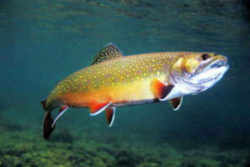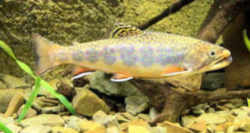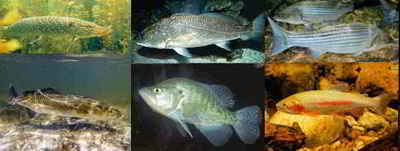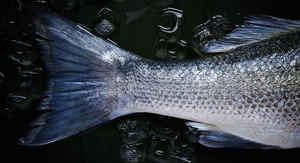Maine State Heritage Fish
Eastern Brook Trout

(Salvelinus fontinalis)
Adopted in 2005.
The eastern brook trout, (Salvelinus fontinalis,) adopted as Maine's official heritage fish in 2005.
Size of the eastern brook trout in Maine varies greatly, depending on water temperature, productivity, and food sources. The statewide average length of 3 year-old brook trout in Maine lakes is 13.3 inches. However, same age trout from different lakes range from 7.5 to 17.5 inches in length. Stream populations are typically slower growing than lake populations. Some high elevation trout populations mature and reproduce at lengths smaller than 6 inches.
The Brook Trout takes first place for the most popular state fish with these states claiming it for their Official State Fish; Maine, Michigan, New Hampshire, New Jersey, New York, Pennsylvania, Vermont, Virginia, and West Virginia. Taken as a whole, trout dominate the Official State Fish category with 18 states calling some type of trout their Official State Fish.
Maine State Heritage Fish: Eastern Brook Trout

The brook trout (Salvelinus fontinalis), sometimes called the eastern brook trout, is a species of fish in the salmon family of order Salmoniformes. It is native to Eastern North America in the United States and Canada. In many parts of its range, it is known as the speckled trout or squaretail.
Maine has the most extensive distribution and abundance of brook trout (Salvelinus fontinalis) throughout their native range in the United States more than 1,000 lakes and ponds (over 760,000 surface acres) contain self-sustaining brook trout populations. In addition, brook trout occur in an estimated 22,248 miles of stream habitat, the vast majority of which are wild. A 2006 range-wide assessment by the Eastern Brook Trout Joint Venture (EBTJV) concluded that:
"Maine is the only state with extensive intact populations of wild, self-reproducing brook trout in lakes and ponds, including some lakes over 5,000 acres in size. Maine's lake and pond brook trout resources are the jewel of the eastern range: lake populations are intact in 185 subwatersheds (18% of the historical range), in comparison to only six intact subwatersheds among the 16 other states."
Characteristics of the Eastern Brook Trout
The average length is 10-12 inches but Brook Trout can be caught measuring up to 21 inches and weighing 4-6 pounds. The largest Brook trout on record was 14.5 pounds and caught in 1916 in the Nipigon River in Ontario. Breeding males develop a hook at the front of the lower jaw. Typical coloring is olive-green to dark brown on the back with silvery sides and pale spotting. All colors intensify at spawning time.
Distribution
The brook trout is native to northern North America and is widely distributed throughout the maritime provinces. It occurs in clear, cool, well-oxygenated streams and lakes.
Adult Size
Size varies greatly, depending on water temperature, productivity, and food sources. The statewide average length of 3 year-old brook trout in Maine lakes is 13.3 inches. However, same age trout from different lakes range from 7.5 to 17.5 inches in length. Stream populations are typically slower growing than lake populations. Some high elevation trout populations mature and reproduce at lengths smaller than 6 inches.
Foods
Brook trout are opportunistic feeders and will eat whatever they can find. In small streams they prefer aquatic insects (nymphs) that live under the rocks and along the stream bottom. They are also known to feed heavily on the adult stage of aquatic insects as they hatch and take flight during their brief courtship and egg laying cycle. Land insects, like ants and beetles, that fall into the water are readily eaten as are small crayfish. They will eat other small fish and minnows but only when they are easy to catch.
Biology
This species spawns in late summer or autumn in gravel beds in the shallows of headwaters of streams. The female digs the redd where she lays 100-5000 eggs depending on her size. They hatch 50-100 days later. The life expectancy is an average of five years. The brook trout is carnivorous and feed upon a wide range of organisms. They have been known to eat their own eggs at spawning time and even their own young.
Maine Revised Statutes
The law designating the eastern brook trout as the official Maine state heritage fish. is Section §212-A (State heritage fish) of the Maine Revised Statutes, Title 1 (GENERAL PROVISIONS) Chapter 9 (SEAL, MOTTO, EMBLEMS AND FLAGS) Section 212-A.
Title 1: GENERAL PROVISIONS
Chapter 9: SEAL, MOTTO, EMBLEMS AND FLAGS
Subchapter 1: GENERAL PROVISIONS
?212-A. State heritage fish
1. Eastern Brook Trout. The eastern brook trout, Salvelinus fontinalis, is a state heritage fish.
[ 2007, c. 21, ?1 (NEW) .]
2. Arctic Charr. The subspecies of the arctic charr, Salvelinus alpinus oquassa, also known as blueback charr, is a state heritage fish.
[ 2007, c. 21, ?1 (NEW) .]
SECTION HISTORY
2005, c. 180, ?1 (NEW). 2007, c. 21, ?1 (RPR).
Taxonomic Hierarchy: Eastern Brook Trout
Kingdom: Animalia - animals
Phylum: Chordata - chordates
Subphylum: Vertebrata
Superclass: Osteichthyes - bony fishes
Class: Actinopterygii - ray-finned and spiny rayed fishes
Order: Salmoniformes - salmon and trout
Family: Salmonidae - salmon and trout
Genus: Salvelinus --
Species: Salvelinus fontinalis








